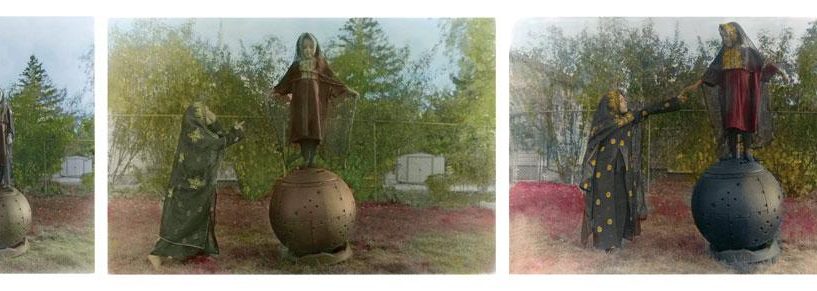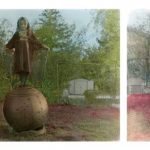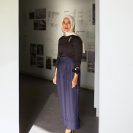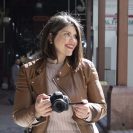As he walked through Mubarakiya, Mohamed Al-Kouh reminisced about shopping trips with his family from his youth. He relished the old souk and cherished it as a part of his own cultural identity. Yet, on that day in September 2012, he walked right by where it used to be. Surprised, he doubled-back to look for the old tarps and mud streets that had been a definitive landmark of Kuwait’s history. They were gone, torn down for renovation and modernization.
“I felt like everything was changing too fast,” he said. “You know when it’s your city but you have no memories there anymore. It’s too confusing.”
So, Al-Kouh channeled his frustrations into a project that he titled “Tomorrow’s Past.” It was the perfect project for the unique medium he worked with, hand-painted black and whites. He photographed buildings that had been erected in Kuwait in the 50s, 60s and 70s, and revived them to their original glory with special paints.
Three years before he began the project, Al-Kouh saw his first hand-painted photo, and it mesmerized him. The woman’s green eyes captivated him, the pearls shone from her dress and there was an undeniable touch of elegance.
“You know when you see something and it strikes you?” he said as his bright eyes looked up to the ceiling, with his hands clasped in front of him. “I saw the photograph and thought, oh my god this is it!”
He researched the dying art, but found it was limited in Kuwait. The process had been popular for a short time in the mid 20th Century, but most of those who had mastered the craft were either dead or had given up the practice long ago. Modern photographers favored the ease of technology over the laborious process. Yet, he knew the connection to the past could be made through the medium. He found the proper camera, and set out to collect original colors.
For his “Tomorrow’s Past” project, Al-Kouh focused on cultural landmarks like the Ahmadi Drive Cinema, Cinema Granada and the Rolls Royce building. His photos are simple wide shots of the buildings, with colors that highlight relics and keep modern indicators in black and white.
“I tried to use the colors to highlight the glory of that time,” he said. “This is my memory. I was inspired by the old colors, and their technique of photography. It was simple, effortless but neat and organized. Everything is there, but it’s empty.”
At the end of 2012 the British Council awarded him a spot in the ‘Out of Kuwait’ art program that would last for a year, and end in an exhibit in London’s Edge of Arabia art gallery. He had used the project to rekindle the memories he had lost, and wanted to do something that would offer emotional conclusion. So, the three photo series, “Touch of Adam,” was born.
Al-Kouh set up a young girl dressed in the traditional Bakhnaq, a black headdress embroidered around the head and the front on a small sphere object, in front of greenery, blocked by a wire fence. This, he says is the past self that landed in the future. An older woman, dressed in an abayya appears in the second photo, shocked to see herself as a little girl and uncomfortable by the memories she evokes. In the third picture the pale, cold green hues are replaced with warm reds as the two are comforted by each other’s touch.
“This is you, you are never lost,” he said. “Even with what is happening around you, you will still be you. Your culture defines you.”
For Al-Kouh, it is the search for culture that drives his work. He remembers the days when Kuwait was the pearl of the Gulf, and the young generation was proud of a country that shone with architectural feats from top designers all over the world. He reminisces about the times when neighbors built their homes with large gardens, and tried to emulate each other’s home designs. It was a time when people shared ideas and worked together, rather than tried to out-do each other.
“People have changed,” he said. “It’s not just a change of the buildings. The whole feel of the place is changing, and not for the better.”
These days Al-Kouh sets up shots in his studio on the 13th floor of the Darwaza building in Kuwait City. As he exits the elevator and looks to his left, the burnt Sawaber buildings remind him of the gloriousness of Kuwait’s past that is forgotten in the city’s rush for tomorrow.
To contact Mohamed you can visit his website at http://www.mohamedalkouh.com









